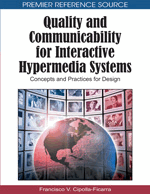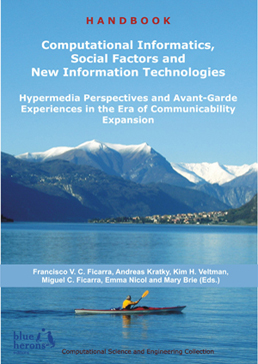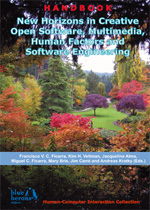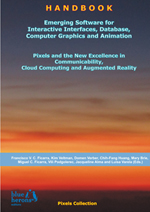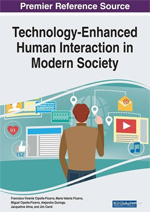Video Games and Aesthetic Function of Computer Graphics in Interactive Systems: Software and Communicability Strategies
:: Omnidirectional Lighthouse Collection ::
:: Author Chapters ::
Editor: Francisco V. C. Ficarra
Editorial Assistants: Mary Brie (La Valletta, Malta) and Luisa Varela (Perpignan, France)
Book Details
• ISBN: 10979-12-80096-01-2 :: DOI: 10.979.1280096/012
• Publisher: Blue Herons Editions
• Location: Italy (Bg)
• Subjects: Communicability, Video Games, Software, Programming, Design, Creativity, 5G
• Subjects: Evaluation, Multimedia, Computer Animation, Interface, Social Networks, Steam
• Subjects: 3D, Computer Graphics, Visual Effects, Playability, Healthcare, Java, Philosophy
• Subjects: Mass Media, Semiotics, Interactive Communication, New Media, JavaScript, C++
• Subjects: Serious Games, Platforms, Motion Graphics, Storytelling, Gestural Interaction, AI
• Subjects: Quality, Gamification, Education, Mobile Learning, Immersive Experience, Uplay
• Subjects: ICT, Entertainment, Ecosystems, History, Script, Comics, Universality, Children
• Subjects: Computer Science, Context, Brain-Computer Interaction, Intellectual Lodestones
• Subjects: Simulation, e-Learning, Cross-Cultural Communication, Realism, Storyboard, HCI
• Subjects: Database, Algorithms, Emulation, VR, Python, Hardware, Emotion, Acteme, UX
• Subjects: R&D, Stadia, C#, AR, MR, GoG, Peripherals, Acting, Motivation, Literature, VFX
• Subjects: Players, Digital Art, Characters, Behaviour Animation, Ethics, Courses, Criticism
• Copyright: 2020
• Collection: Omnidirectional Lighthouse
• Series volume: I
• Publication date: December, 2020
• Binding: Paperback
• Grade level: General
• Language: English
• Illustrations: Yes
• Colour: Yes
• Pages: 188
• Dimensions: 11.41x8.26x0.51 in. 1.33 lbs. :: 290x210x13 mm. 604 gr.
Preface
It is the Supreme Art of the Teacher to Awaken Joy in Creative Expression and Knowledge.
Albert Einstein (1879 – 1955)
Once again, university research for a doctoral thesis in the USA would mark a historic milestone for the birth of a new industry, related to entertainment: video games. In 1952, Alexander Sandy Douglas, developed the first video game with the platform EDSAC (Electronic Delay Storage Automatic Calculator) for a single player called OXO, popularly known as "noughts and crosses." The strong impulse in the '70s, from electronics and computer science, would allow to establish the foundations of a thriving industry, which since then and annually, has not stopped growing. Keyboards, mice, joysticks, touch screens, among other devices for interacting with video images. Video game platforms (arcade machines, video game consoles, computers, tablets, smartphones, and so on) have been diverse and denote the temporal evolution of new communication and information technologies.
Since the first commercial video games that used personal computers, there has always been the need to contact another person, or to install it, understand the instructions and exchange information about the operation or tricks to overcome certain obstacles, if they existed. Therefore, they implicitly carried the need to socialize and communicate with the other. This communication process boosted the formation of groups inside and outside the classroom, for example, in order to delve into issues related to video game hardware and software, especially with the rise of the first “clone” multimedia computers. (IBM PC compatible), in southern Europe. It was a natural process, where students, teachers and parents could share playful moments, watching the development of imagination and group and individual skills, not only in the interaction with the systems, but at the time of acquiring them in specialized stores, the loan and exchange between colleagues, etc. It was a natural way to activate in many of these young users the interest towards their programming, when they accessed university degrees. Many of these young people have achieved these goals, through university study or simply as self-taught, since in the previous century, it was considered a mere hobby. Temporary realities where terms or expressions, such as: emotions, human affectivity and other nonsense associated with those words, from the UCD, UX, HCI, etc., were not necessary to motivate them to program.
However, that playful pastime, today has become a great planetary industry. However, in the new millennium the “serious and professional” didactic problem persists, which goes from design to programming, passing through efficient evaluation of the same. There are endless actions of public and / or private entities, which only fulfill the bureaucratic, commercial, journalistic, and so forth. function. For example: establishing agreements between training institutions and the business environment, making intercontinental trips to sign documents, conducting banal interviews and photographs (eating or sucking on microphones), in the media, etc. Hypothetically, all this is done in order to strengthen ties of cooperation and collaboration, educational quality and innovation, technological infrastructure and development of support tools for the design, development and fine-tuning of digital content, specialization courses and teacher training in video games, and training of technical managers, and an extensive etcetera, which only remains on paper. We repeat, in our days and outside certain borders, adolescents are already programming excellent video games.
In other words, there is a kind of need to go back to the past, when children, adolescents, parents and grandparents of the late twentieth century had more fun interacting with video games as a family, because among so many other things, intergenerational dialogue was encouraged, something that does not exist with the current individual and narcissistic fruition. Moreover, the high quality of the final product depended on a group of developers, who watched over each of its components. Many times, all of them are governed by one of the basic pillars of learning by playing: "Communicability." A communicability that should be implemented in new professionals since the boom of the first multimedia systems, in the 90's, but for exogenous reasons has not been developed in the old continent. Perhaps, the reduction of production costs, keeping the final quality high and in the shortest time possible, are variables that were not of interest in certain training contexts, of the European Mediterranean.
The miniaturization of video game device screens has fostered individualism. The field of entertainment or pastime is not exempt from such phenomenon. This sociological factor entails other consequences. We refer to the new challenges that are being opened with video games that will resort to mixed reality. The main software houses, especially those historical and related to operating systems, such as Microsoft, are already developing new technologies. In such devices or platforms it will be difficult for the player to maintain the dichotomy between the real and the virtual of the images. If we add artificial intelligence and quantum computers to this phenomenon, the changes that are coming in the video game industry will really mean a Copernican revolution. This is the main motivation of this research work to remember where we come from, know where we are and plan for the future.
Some examples of video games that have marked a milestone in group (family, colleagues, friends, and so on) or individually enjoyment:

Pac-Man (1980 - Japan)

Tetris (1984 - URSS)

SimCity (1989 - USA)

The Interactive Alphabet (Corel, 1985 - Canada) is a classic example of video games for children to learn-to-read while playing.
Introduction
In the evolution of interactive systems and the Internet in the late 1990s, the video game industry would become a thriving industry in the 20th century. It is enough to remember some titles such as Final Fantasy VII (1997), Star Wars: The Old Republic (2011), Destiny (2014), whose budgets in dollars for development and marketing, have 9 figures. At the same time, while the bubble created around e-commerce and virtual companies exploded, at the beginning of the 21st century, the production of multimedia systems maintained its constant growth thanks to the video game.
Examples of Japanese and American video games, whose budget to make and market them is between 100,000,000 - 500,000,000 million dollars:

Final Fantasy VII (1997 - Japan)

Star Wars: The Old Republic (2011 - USA)

Destiny (2014 - USA)
In other words, with the turn of the century and millennium, thousands and thousands of real companies disappeared, some of them centuries old, that had invested practically all their financial resources in the network, throughout our planet. In this context, online and offline videogames saved the incipient growth of multimedia. Subsequently, it would far exceed the international financial crisis of the new millennium. Today, it has not only established itself as a vigorous industry in the ICT (information and communication technology) sector, but also professionals adapted to it are being trained. The curricula are already adjusted to this industrial sector. Located in the Alps, technical institutes or specialized high schools have young students (under 18 years of age) who learn how to design, program, evaluate them, etc. Therefore, this democratizing phenomenon of learning by playing with emerging interactive technologies, must be examined from its origins, analyze the present and broaden the look towards the future of this thriving industry. This is why we light this omnidirectional lighthouse.
A visible and accessible lighthouse for all those interested in continuing to navigate firmly in the video game systems, braving storms and resisting the hurricane-force winds of the environment, where users are immersed. In short, guide them so as not to run aground on the cliffs of obscurantism, derived from naivety and / or ignorance. The chapters are: Video Games: Historical Evolution; Mass Media and Virtual Worlds; Aesthetic Function and Design; Communicability Strategies; Computer Graphics; Animation; Motion Graphics; Visual Special Effects; Multimedia Mobile Systems; Mixed Reality for All; Software Programming; Emerging Technologies; Video Games for Empowering Mental and Physical Health; Serious Games and Edutainment; Learn Playing: Principles and Philosophy; Socialization versus Individualism; Guide to the Best Schools and Universities; Methodologies of Assessment and Vademecum for Video Games Quality; Video Game Statistics, and The Immediate Future.
The present handbook begins with an abbreviated but detailed study of the history of videogames. Through a systematic literature review, it is investigated how the evolution of hardware and software has allowed millions of users of interactive systems to be introduced and maintained over time and in the daily life, with the purpose of pastime, entertainment, learning, maintenance among the users of their physical and mental faculties, among many other functions. In this temporal evolution, it is important to investigate how video games have resorted to the means of social communication or mass media. Or its diffusion and acceptance among the population until it reaches the understanding and enjoyment of virtual environments or worlds. That is, 2D / 3D images and audio. Environments where interfaces, the use of metaphors, iconography, typography, and so on, acquire an important role from an aesthetic and functional perspective. Each of the elements that make up these interfaces and the context in which potential users may be immersed are considered design categories. An interactive design that requires a set of stratagems or tactics to achieve the highest quality level in the communication and interaction process in the shortest possible time. All these components of videogames are essential in the era of expanding communicability.
A communicability that leaves the real world of video and TV. Through the computer, this reality can be emulated or simulated, in 2D and / or 3D. As technological resources progress, the same happens with the programming of these synthesic images, until results are obtained, where currently, it is difficult to differentiate between the real and the virtual. Now, one of the elements that have most attracted the attention of users since the first video games is to be able to manually move elements of the image on the screen, through the keyboard or the joystick, to name two examples, accompanied by sound effects. Sounds and music that were activated when certain objectives were reached within it. Consequently, the various types of animation require detailed consideration, as do motion graphics and visual effects specials (VFX). The latter have doubly favored the increase in users. The first through the influence received through film and television. The second with the constant progress of video games, where the animation component prevailed over the static elements on the screens.
With the increase in broadband on the Internet and the reduction in the costs of smartphones, video games have left the static realm of the home and have moved to the "mobility of space for enjoyment" mode, with a high quality of resolution of animated images. This qualitative leap in online multimedia communication has democratized access to video games. Social networks have enhanced this phenomenon, reducing the age of the users (children), as well as expanding them for adults (parents and grandparents). In other words, they have established generational bridges. That generation leveling has set a new look at augmented reality and mixed reality. The latter will be favored when the operating system software makes new systems where the user can interact and manipulate holographic objects in 3D, for example. We point out from now on that mixed reality is a challenging frontier, which will require a new cognitive effort on the part of users, since they will constantly interact with objects in 2D, 3D, real or virtual, in fractions of a second.
These are images that can refer to a video, a comic, a drawing, a photo, a 3D object, etc., these continuous changes require a culture of very high visual adaptability, so as not to lose the notion of realism or virtuality. Obviously, all this requires a new paradigm in design based on an innovative technological support (graphics cards, processors, sound cards, and so on), small in size and interconnected to the network. All of this must be tied to traditional or new programming languages. The intention is to promote a new generation of video games, among current and future users. This new gap between devices and video game content should maintain current functions such as attending physical or sports activities for adults, for example. Simultaneously, help in those cognitive tasks related to memory, mathematical dexterity, logical problem solving, and so forth.
Now, there are countless studies that show the negative aspects of video games, ranging from the poverty of the content, failures in the interaction, etc., to the temporary abuse in the use of them. Other research works refer to the decrease in reading attention, the inability to mentally perform simple mathematical calculations, without using calculators, to name a few examples. In other words, the conclusions of these studies indicate a negative influence on the educational function of video games. Consequently, it deserves a critical and constructive look at the main issues that refer to serious games and edutainment, and especially those that come from sociology, cultural systems and social psychology. Hence the need to review the philosophy of learning by playing. Together with the need to incorporate specialists in communicability, in each of the phases of the development of serious games and edutainment, for example. The main purpose is to promote the socialization of people through the use of interactive systems aimed at the game. These are video games that promote other possible collaborative activities, which should be done almost naturally. This is a way forward to eradicate the social and individual isolation of users in front of plasma screens, whether they be computers, smartphones, tablet PCs, video consoles, among others.
These educational considerations implicitly entail the selection of those areas where it is possible to study and constantly update oneself for the realization of video games. In this sense, it must be remembered that in many places there are university studies such as masters and even doctoral programs, in other parts of the world, studies in high schools or technical institutes specialized in computing, telecommunications or electronics, applied to video games. Consequently, it is necessary to have a list or guide of good references, in this regard. As well as an updated and verified formulary to evaluate the quality of video games, using valid methodologies, and carried out by authentic experts in communicability (point of view of training and / or experience). All this information implies knowing very well the state of the art of the video game industry, from a quantitative point of view. That is, data related to the productive market, consumers and trends, under the classic format of statistics. Therefore, it is necessary to recognize those reliable sources to obtain this type of information. In short, eliminate bad data and false news. Information that is not normally online. Therefore, it is a difficult task to compile it and produce the relevant reports. A generic material that can be used by entrepreneurs, merchants, developers, users, and other agents that directly and indirectly intervene in the video game industry.
Finally, it is advisable to be constantly updated with the latest technological developments, especially those from hardware, IoT (Internet of Things), AI (Artificial Intelligence), 5G, etc., added to the constant fluctuations of the local and global context. Depending on these and other variables, the new demands of potential users will be met in the best possible way. The historical evolution, the lessons learned, the attentive look at the present and the trends of the users, allow the generation of new lines of action, to keep the growth of video games constant and current.
Francisco V. C. Ficarra
San Pellegrino Terme, Italy (December 2020)
Partial Content On-line (pdf format)
• Front Cover (here)
• Preface :: Acknowledgment (here)
• Chapters :: Final Remarks :: Author Index :: Keywords Index :: References ... (here)
• Back Cover (here)
Additonal Handook Info
• Only paper copy – no digital book on-line and/or off-line –
• Special Price € 95 (expedition cost not included) ... e-Commerce :: Info Form
Welcome to Blue Herons Editions!
The origin of this publishing project is to be found in the Canadian lands, where nature presents itself generous in many places of its wide geography. More ...
Education, Communicability, Design, Computer Science, HCI, Computer Graphics and Computer Animation:
We focus on education and new technologies with 40 years long experience. More ...
Literature and Journalism:
Intersection between universal literature, local new journalism (true stories), sociology and legal immunity. Two collections:
- Casoncelli Bergamaschi
It is a typical bergamasque dough filled with meat, similar to the raviolis. More ...
- Menjar Blanc & Black
It is a typical sweet of the Catalan coast and the Balearic Islands. More ...
Others Releases:
See all others new releases in books, CD, DVD, etc. More ...

Call for Papers, Short Papers, Posters, Demos, Research-in-Progress, Workshops, Doctoral Consortium, Hardware & Software Companies - Didactic Demos Sessions ...
ADNTIIC 2020 :: HCITOCH 2020 :: SETECEC 2020 :: HIASCIT 2020 :: CCGIDIS 2020 :: IPCTIIC 2020 | HCITISI 2020 :: MSIVISM 2020 :: RDINIDR 2020 :: ESIHISE 2020 :: HCIHEART 2020 :: QUITANS 2020 :: ITSIGUI 2020


